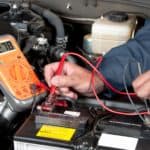
MENUMENU
TALK TO AN EXPERT
Special Hours: 7AM – 6PM PST
TALK TO AN EXPERT
Special Hours: 7AM – 6PM PST
It’s no secret that the batteries you put in your TV remote are not the same as the battery under the hood of your car. Your application typically determines the type and size of battery you need; sometimes, you may have multiple choices that will work. Today, we will dig deeper into the different batteries available and how to choose the best battery size for your system.
The importance of standardizing batteries is probably not something you think about every day and is likely something we all take for granted. If the AA batteries in your flashlight die, you expect that if you buy replacements, they will fit and work just like the previous ones did. But, without standardization, this would not be the case.

The International Electrotechnical Commission (IEC) publishes international standards for all electrical and electronic-related technologies, including batteries. Non-rechargeable or replaceable batteries fall under the IEC standard 60086, and rechargeable batteries, such as automotive and lithium-ion batteries, are standardized according to IEC 60095.
The most common battery types for small household electronics are AA and AAA. Both are cylindrical batteries with a nominal voltage of 1.5 volts. AAA batteries are physically smaller than AA batteries and typically have about half the capacity. Remote controls, small flashlights, and similar small electronics requiring minimal power often use AA and AAA batteries.
The most common options for larger, battery-powered household electronics are C and D batteries. D batteries are larger than C batteries and have about 50% more capacity. C and D batteries are often used in higher-power applications such as portable stereos or industrial electronics that need to run for a longer time.
Finally, E batteries, commonly called 9-volt batteries, are the last common household battery. 9-volt batteries are rectangular and typically power smoke detectors and similar electronic devices.
Battery cells typically come in three standard shapes: button, prismatic, and cylindrical. These different cell shapes come in different sizes and chemistries and are optimized for various applications. Typically, smaller battery cells are connected in series or parallel to make larger batteries. For example, it’s common to construct deep-cycle lithium batteries out of many individual cylindrical or prismatic battery cells.

Button cells are small round batteries that look like buttons and are common in very small electronics that require minimal power. For example, watches, car key fobs, hearing aids, and medical devices all use button cell batteries.
Prismatic cells are thin, rectangular battery cells that are becoming obsolete. They are expensive to manufacture and do not have good thermal management, which tends to cause them to have a shorter lifecycle than cylindrical cells. Low-profile devices like phones, tablets, and laptops often use prismatic cells.
Cylindrical cells are the most common cell type. Some common household batteries mentioned earlier (AA, AAA, C, and D) are cylindrical cell batteries. Cylindrical cells are the most robust cell type, and when combined in a battery pack, they offer a higher energy density than prismatic cells.
→ Learn more here at Lithium Battery Basics: What’s Inside A Lithium-Ion Battery?
In North America, the Battery Council International (BCI) publishes standard group sizes for rechargeable battery types like those found in cars, boats, and RVs. The group size determines the physical dimension constraints of the battery, not the capacity. Typically, a larger battery results in a higher capacity. However, this is not always true.
There are over 50 different battery group sizes. The battery size chart below shows some of the most common ones designated by BCI group size number.
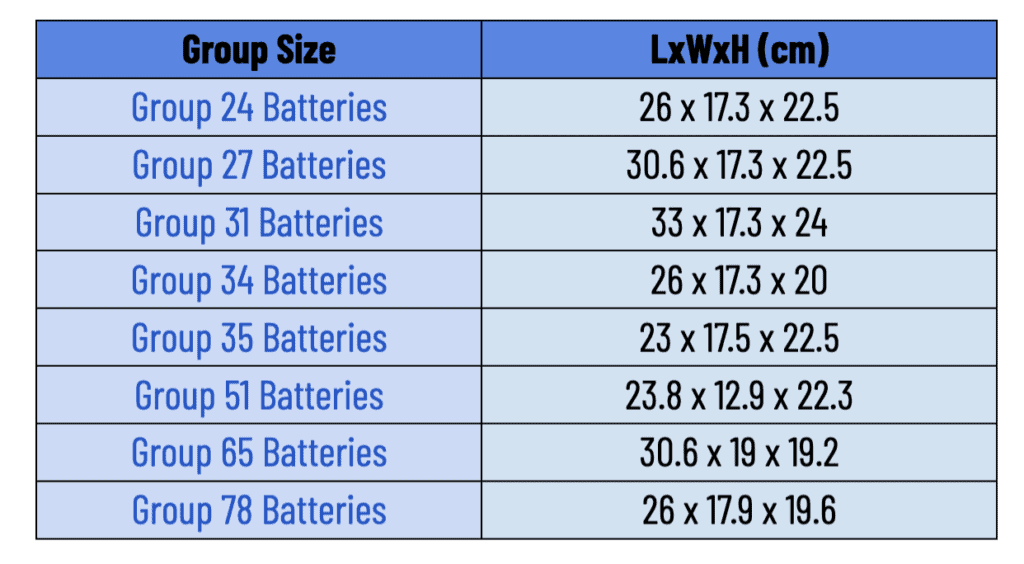
A common misconception is that the larger the group number, the bigger the battery. This is not always the case, either. For example, a Group 31 battery is larger than a Group 51 battery.
There is no single group size that all cars, RVs, boats, or golf carts use. Vehicle manufacturers have recommendations that can help you choose the best battery size for your system.
While there are some exceptions, the most common battery group sizes for passenger vehicles are 24, 27, 34, 35, 48, 49, 65, and 78. Many RVs and boats will use group sizes similar to passenger vehicles.

Golf carts also have size groups preceded by the designator “GC.” The most common battery for golf carts is the GC2, which is a 6-volt battery. Other golf cart battery options are the GC8 (8 volts) and GC12 (12 volts).
→ Find out Everything You Need To Know About Golf Cart Batteries
Standard batteries typically fall into four primary battery chemistries: lead-acid, nickel-cadmium (Ni-Cd), nickel-metal hydride, and lithium-ion. Within these four primary chemistries, there are multiple sub-chemistries. For example, many different types of lithium batteries with varying applications are ideal for each.
The critical difference in the four primary chemistries is energy density. The graph below shows that lithium batteries have the highest energy density, followed by Ni-MH, Ni-Cd, and finally, lead-acid. A higher energy density means more energy can be stored in a smaller, lighter battery.
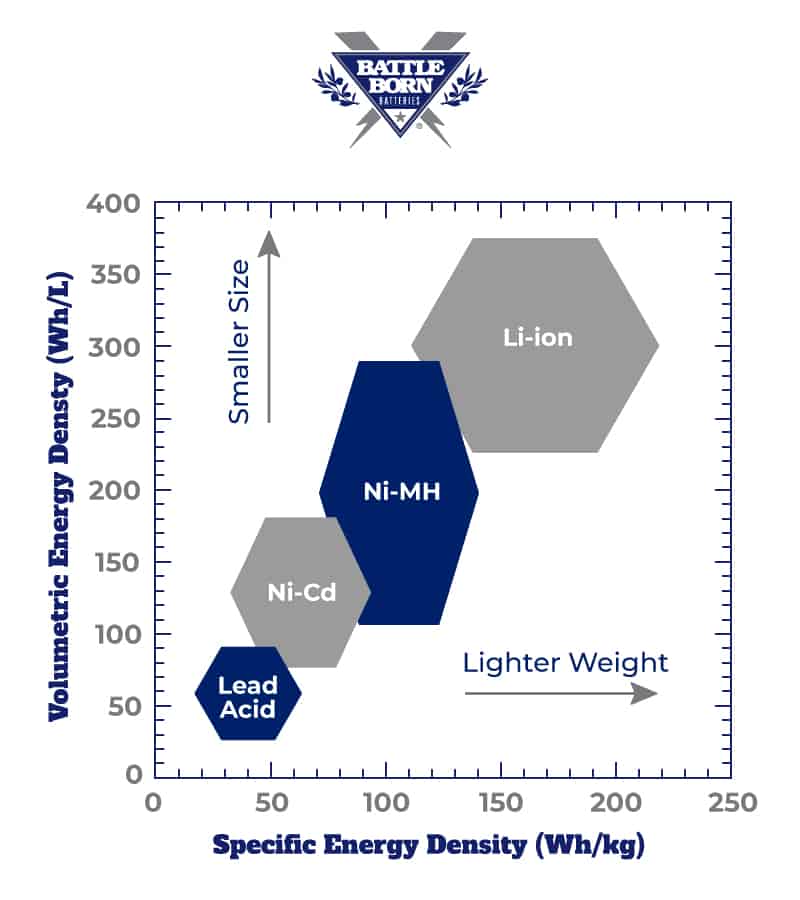
Energy density is not the only factor in choosing the best battery chemistry for your application. The different chemistries have trade-offs as well. For example, lead-acid batteries make better starting batteries than lithium batteries. Lead acid batteries can provide extremely high cold cranking amps (cca) that produce short bursts of high current to start your car. With a much higher CCA rating, lead acid batteries are best for starting applications.
Not only do batteries come in different physical sizes, but they also have varying voltages. Battery voltages can range from 1.5 volts in AA and AAA batteries to 48 volts for some deep-cycle batteries.
A good rule of thumb is that the higher the power requirement for an application, the larger the battery voltage needs to be. The power a battery can produce is equal to the product of its voltage and current measurements ( voltage (volts) X current (amps) = power (watts) ). In high-power applications, having a higher voltage reduces the current, allowing smaller cabling to be used.
The final and possibly most important factor in differentiating a battery’s size is the battery’s capacity. We measure battery capacity in amp-hours (Ah), which is the product of multiplying amps (current) by hours of run time.
→ Suggested Reading: What Are Amps and Amp-Hours?
For example, a battery with a 100 Ah capacity can deliver approximately one amp for 100 hours, two amps for 50 hours, four amps for 25 hours, and so on. However, it is essential to remember that the capacity rating is an approximation, and is not exact.
Battle Born Batteries offers various sizes of lithium deep-cycle batteries in varying form factors, voltages, and capacities.
Our flagship 100 Ah 12-volt LiFePO4 deep cycle Battle Born Battery is the perfect drop-in replacement for group 27 and group 31 lead-acid batteries. This means this battery fits in the same space and size constraints as its lead-acid counterparts.
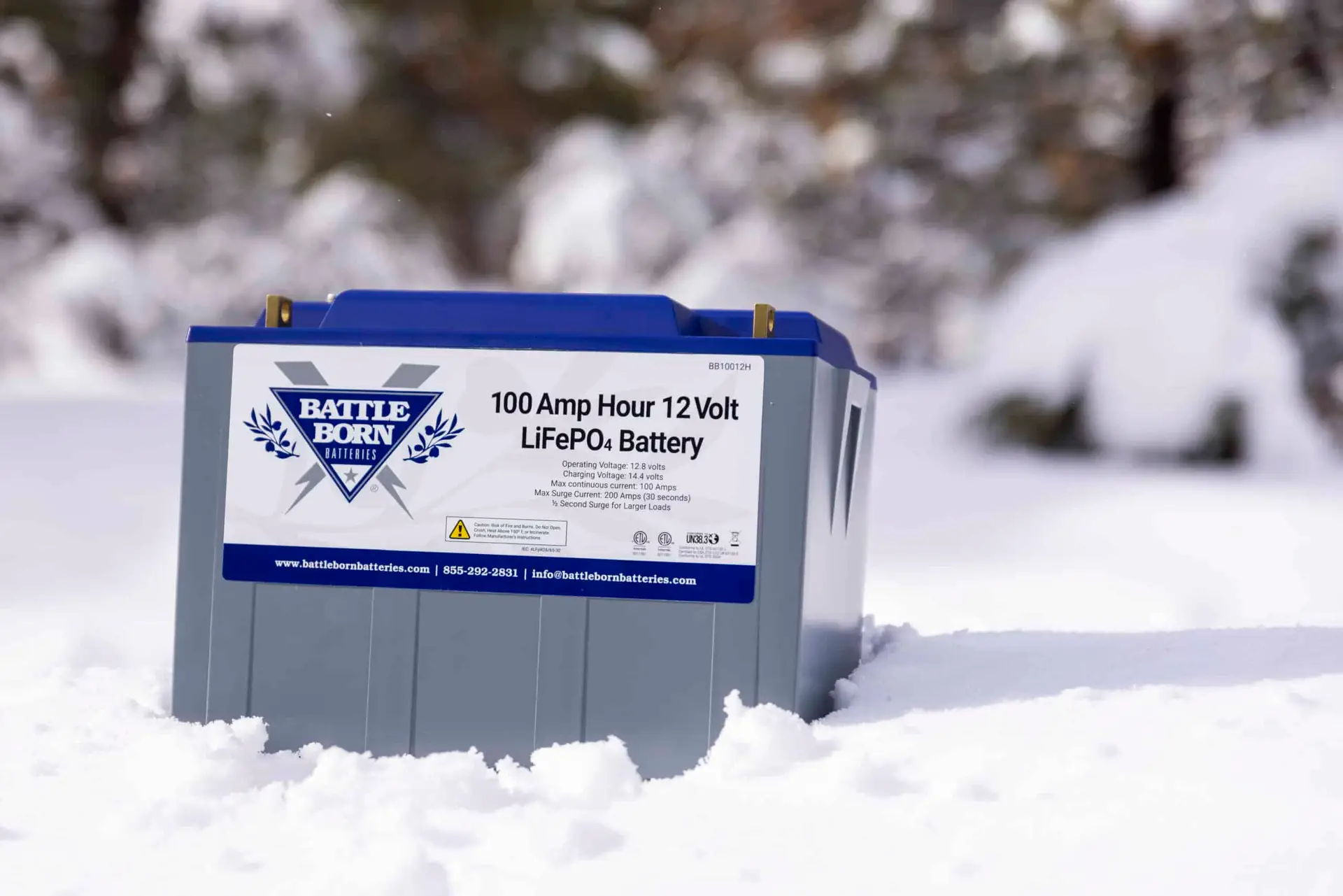
We also offer our 100 Ah battery in a GC2 form factor for golf cart applications. GC2 form factor batteries are typically 6 volts. However, most golf carts run on 24 or 48 volts, so this application often requires up to eight 6-volt batteries in series. Since our GC2 battery is 12 volts, you need half as many batteries in your golf cart, saving you weight and space.

Additionally, we offer three smaller-capacity batteries. The first is a 24-volt, 50 Ah battery. This is also a drop-in replacement for group 27 and 31 batteries. While it only has a 50Ah capacity, the watt-hour capacity is the same as our 100 Ah, 12-volt batteries. Then, we have a 50 Ah and 75Ah 12-volt lithium battery for smaller applications that don’t require much power. These batteries weigh 22 and 27 pounds, respectively, which makes them perfect for on-the-go applications.
Finally, we’re changing the game with our 12V 270Ah LiFePO4 deep-cycle battery. The Battle Born GC3 is a big battery with a unique form factor that changes how batteries can be placed inside RVs, boats, or other applications. Rather than adhering to a traditional group size that needs to fit in a battery box, we have created a battery that can be placed anywhere. With the ability to be mounted sideways, stacked on each other, or even upside down, this battery is perfect for various applications.
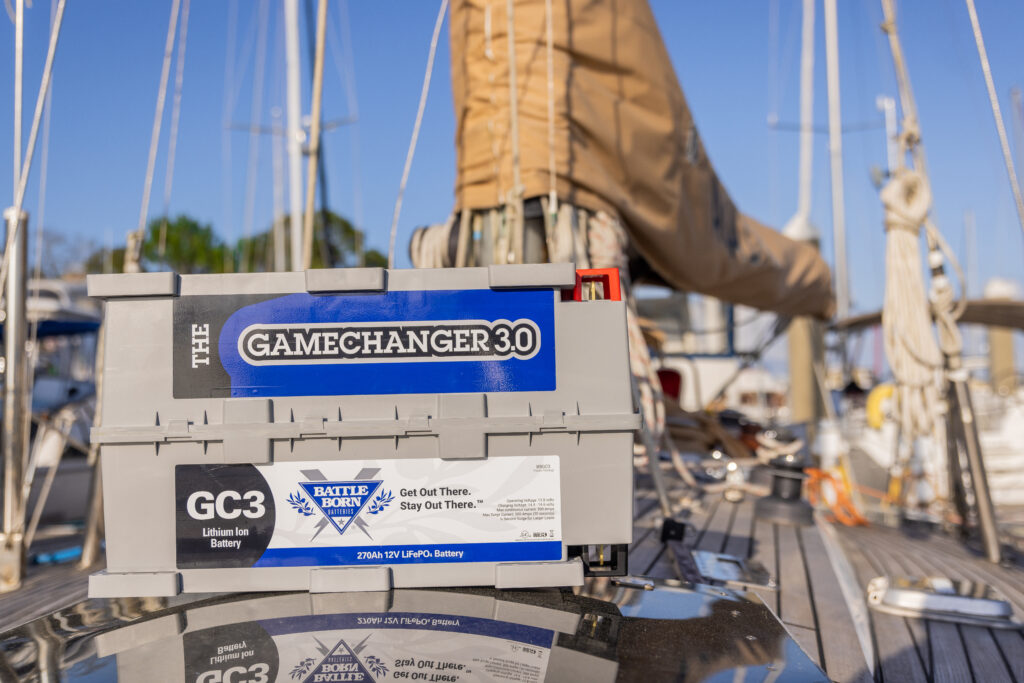
Choosing the right battery size for your system and application is about more than just getting the biggest battery you can find and afford. There are many different form factors, voltages, and capacities available.
Before jumping in and buying a new battery, determine what your power needs are, how much space you have available, and your budget. Whatever your combination of needs is, a variety of batteries would likely work for your application.
The Battle Born Battery Calculator is a great tool to determine what size batteries you need. Input the power consumption of your electronic devices, and it will output the number of amp-hours of batteries your system requires. Then, you can determine which battery size is best for your system based on your space and weight constraints.If you need further assistance, our team of technical experts is always happy to help! You can reach them by calling (855) 292- 2831.
We know that building or upgrading an electrical system can be overwhelming, so we’re here to help. Our Reno, Nevada-based sales and customer service team is standing by at (855) 292-2831 to take your questions!
Also, join us on Facebook, Instagram, and YouTube to learn more about how lithium battery systems can power your lifestyle, see how others have built their systems, and gain the confidence to get out there and stay out there.
Shop Best Sellers

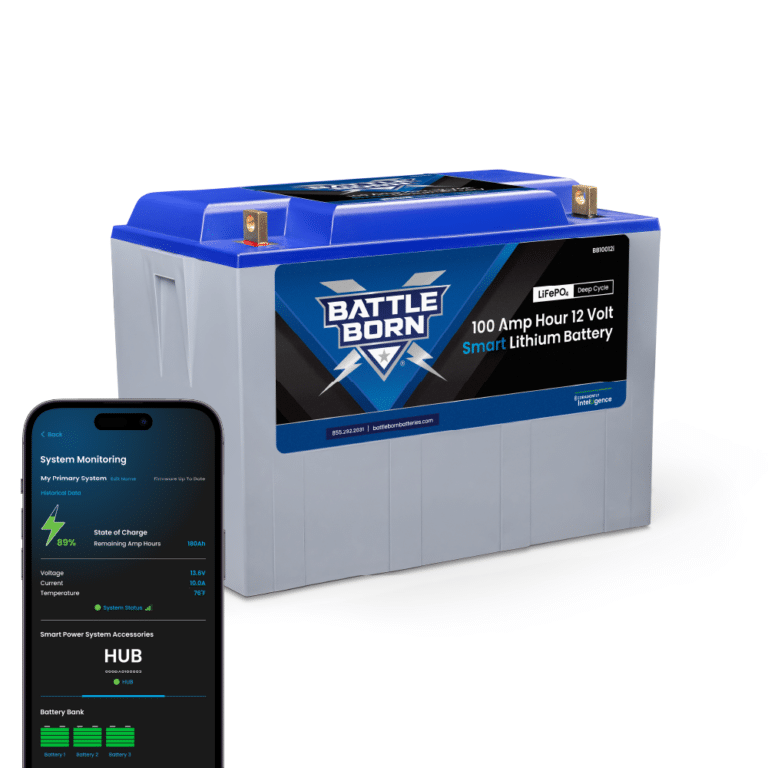

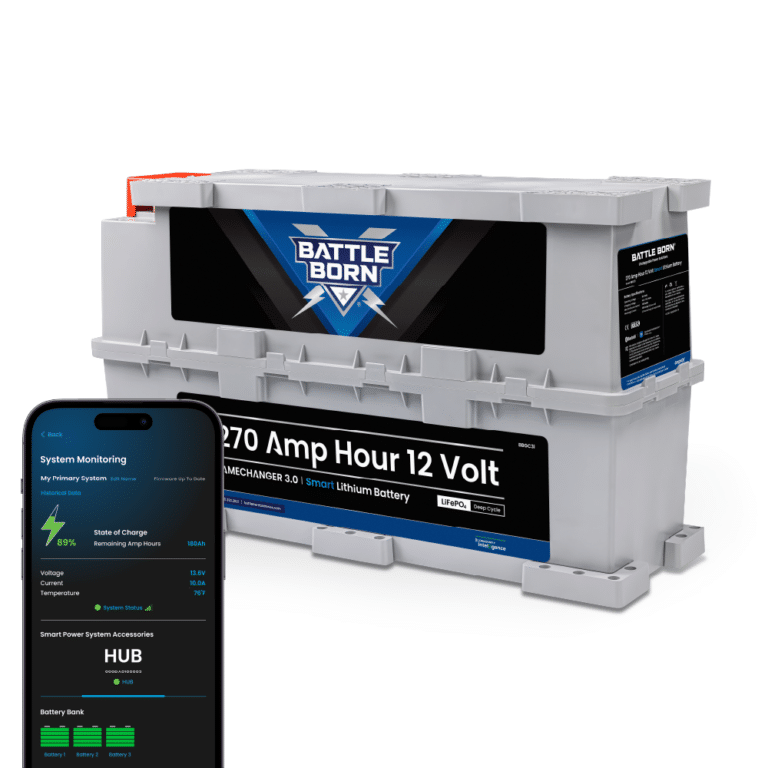




Ask a technical specialist now at 855.292.2831
Stay in the Know